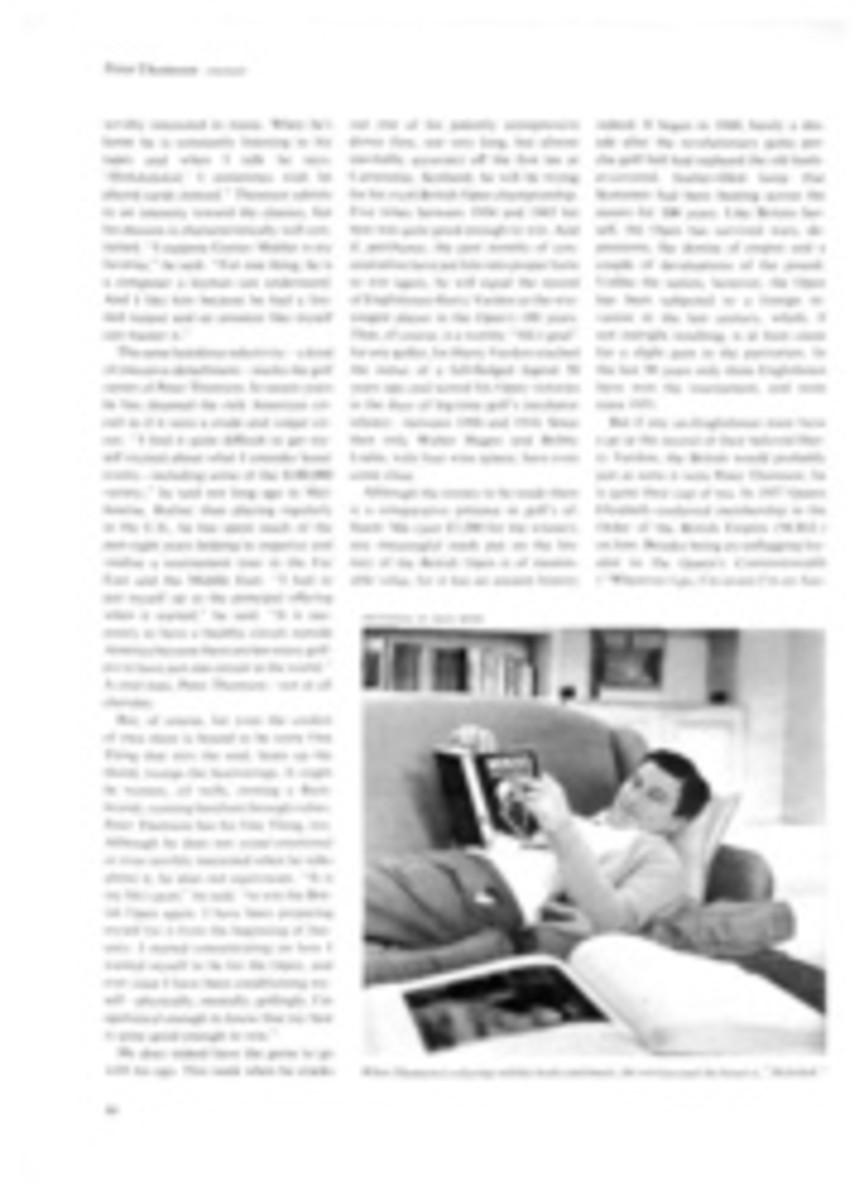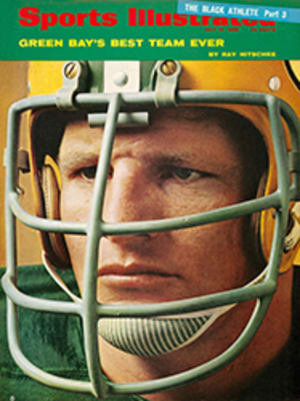
A WIDE-OPEN SMASH
When night finally settled last Saturday on the 12th and final day of the first open Wimbledon tennis championships, three significant conclusions could be drawn. First, Rodney George Laver, 29, of Newport Beach, Calif. via Rockhampton, Australia, and Billie Jean Moffit King, 24, of Berkeley, Calif. via Long Beach, are two of the finest players in the history of the game. Second, a lot of folks who thought the tournament was going to be a cakewalk for the professionals wound up hiding under the stands. Finally, if the U.S. doesn't win the Davis Cup this year it never will.
In brief, Wimbledon '68 was a wonderful, revolutionary tennis tournament. There were touches of pathos and touches of humor, and there was just the right amount of nostalgia. Six former men's champions were entered: Lew Hoad (1956, '57), Alex Olmedo ('59), Laver ('61, '62), Roy Emerson ('64, '65), Manuel Santana ('66) and John Newcombe ('67). There would have been a seventh if Frank Sedgman ('52) hadn't picked up a classic tennis elbow trying to work himself into shape for the event. Three former women's champions also were on hand: Margaret Smith Court (1963, '65), Maria Bueno ('59, '60, '64) and Mrs. King ('66, '67).
Even the weather, which was horrible, could not destroy the Wimbledon magic. The first five days were played in a constant, cold, blustery downpour. The resulting delays jammed up the second week with extra matches, and cost Wimbledon 23,000 fans. The first round of men's singles took four days to play instead of the allotted one. Then, on the second Monday, red Sahara sand that had been sucked into the atmosphere by a freak wind got deposited on England by a freak wind. Finally, a heat wave (93° in London, 104° on center court) took over for a day before the weather leveled off and allowed things to get finished on time.
Taking the three conclusions in reverse order, the U.S. Davis Cup chances look better than good, mainly because Clark Graebner and Arthur Ashe are playing the best tennis of their lives. Ashe and Graebner, who never before had made it past the fourth round, both turned in a pair of stunning upsets, at least by recent U.S. standards, and made it to the semifinals. "The fourth round this year was supposed to be the promised land," Graebner said. "This has got to mean something." Graebner defeated Santana and Fred Stolle in straight sets, while Ashe put out the defending champion, Newcombe, and Tom Okker of the Netherlands, who was named before the tournament as the most likely to succeed among the amateurs. And if Graebner and Ashe were not enough Charlie Pasarell, who is, after all, the top-ranking player in the country, also looked impressive in losing to Ken Rosewall in five sets.
For the first time since 1950 Wimbledon seeded 16 men, which was a tribute both to the depth and strength of the field and to the confusion brought on by the fact that there are now essentially three groups of tennis players who rarely compete against each other: the amateurs and two sets of pros, the George MacCall group and the so-called "handsome eight." As Pasarell said, "There were at least 30 players who could have been seeded." Of the 16 who were, only Ashe, Santana and Okker were amateurs. But as the tournament slowly moved ahead, it became evident that the pros did not deserve such lofty consideration. For example, Niki Pilic of Yugoslavia, seeded 16th, was defeated by Herb FitzGibbon of Garden City, N.Y. in the first round. In the third round, in quick succession, Hoad (No. 7) lost to Bob Hewitt, an Australian living in South Africa; Pancho Gonzalez (No. 8) lost to Alex Metreveli, a 23-year-old Russian; Andres Gimeno (No. 3) lost to Ray Moore, a bearded, longhaired South African; and Cliff Drysdale (No. 14) lost to Tom Edlefsen, an American who is unranked because he fought total paralysis from a hospital bed for five months last year.
The fourth round was even worse for the pros. Okker defeated Roy Emerson (No. 5), Ashe defeated Newcombe (No. 4) and Graebner defeated Stolle (No. 11). Of course, Wimbledon loves its upsets, and the crowds took to all of this with great glee. The happiest fellow around was Harry Hopman, the crusty former Aussie Davis Cup captain who has developed at least 20 world-class players only to see them desert the amateur ranks and play for—ugh—money. Said Hopman, "Maybe now the people will come out and see the bloody amateurs play again."
There were many excuses offered on behalf of, and by, the faltering pros. Some were valid, some a bit ragged on logic. On the pro tour, play is nearly always indoors, best-of-three sets, a series of one-night stands in which the overall record is more important than winning or losing a particular match. Wimbledon, of course, is best-of-five, and the amateurs who play the world circuit are tournament-tough and know what it's like to play key matches in important championships week after week. As Gonzalez said, after last month's French Open, "Paris renewed my respect for tournament tennis. I've got to get conditioned to it again."
Wimbledon nerves affected nearly all the professionals. The pros usually said, "It's great to be back but I'll be glad when it's over," and the amateurs who beat pros usually said, "I had everything to gain and nothing to lose." Perhaps, but the biggest reason for the upsets was that they weren't really upsets. Of the full-time touring professionals who were seeded, only four—Laver, Rosewall, Gimeno and Butch Buchholz—were not amateurs two years ago. Some, like Stolle and Emerson, never were superplayers, and others, like Drysdale and Pilic, turned pro long before their peak. The amateurs who beat them are good and are looking for a piece of the action. In fact, it could be argued that there was really only one major upset in the entire two weeks: Ray Moore's five-set victory over Andres Gimeno, and all Moore got for that was a letter from a South African tennis official suggesting strongly that he get his hair cut if he wished to play Davis Cup.
And so, after all the tumult and shouting of the first four rounds, the quarterfinals paired Laver against Ralston, Ashe against Okker, Graebner against Moore and Buchholz against Tony Roche, who had put out Ken Rosewall in straight sets. Four Americans in the round of eight, four amateurs in the round of eight. Ralston, as it turned out, gave Laver his toughest match of the tournament, extending him to five sets. Ashe and Graebner won without too much difficulty, and Roche defeated Buchholz, who played with a pulled groin muscle he had suffered the week before Wimbledon.
The semifinals put Laver against Ashe and Roche against Graebner—two right-handed American amateurs with booming services and very little touch to back them up against two left-handed Australian pros with good services and nearly everything else to support them.
U.S. Davis Cup Captain Donald Dell, highly pleased at seeing two of his team members reach the semis of the first open Wimbledon, said, "It's like when Casey Stengel was managing the Yankees. All I have to do is watch. Those little fuzzy things are like rockets. When Ashe and Graebner are serving missiles like that, there's no way they can lose."
When they're not, however, bad things can happen—and they happened very quickly. Ashe began the match well, but at 5-all, 30-all in the first set, Laver hit two marvelous forehand service returns. The first was an outright winner, the second forced a volleying error for the vital service break. Laver held his service for the set, then ran out the next two at 6-2, 6-4. At the end Ashe was just smiling a bit in resignation and shaking his head.
The Graebner-Roche match was closer, but, like Ashe, Graebner was not serving outright winners as he had earlier in the tournament and, wonder of wonders, was not following his serve to the net. There were 16 service breaks in the four-set match, and Roche, whose return of serve is among the best in the game, won 9-7, 8-10, 6-4, 8-6.
For the eighth time in 13 years Wimbledon had an all-Australian men's singles final. Laver, who played the entire tournament with a bone bruise on his left wrist covered by an Ace bandage which was hidden by a sweatband, has a $90,000 yearly guarantee. Roche's is $40,000. Those were very proper odds. For the third time in his three final-round matches Laver defeated his opponent in straight sets, 6-3, 6-4, 6-2, and in an hour or less, becoming the first player since Fred Perry in 1934, '35, '36 to win three Wimbledon titles.
Billie Jean King did not win her third straight singles championship without a struggle, one which actually began last month after the French Open, in which Nancy Richey defeated her in three sets.
"I was rooming with Rosie Casals," she said, "and I woke up one night and said, I can't stand it. I'm fed up. I want to go home. I can't stand the sight of a tennis ball.' " Three months on the pro circuit had gotten her down, both mentally and physically, and she caught the first plane back to California, slept for 21 straight hours and went to her doctor, who discovered that she was again having a problem with a thyroid deficiency. A week later she was back in England, but hardly ready to defend her Wimbledon title.
"I'm playing the worst tennis I've played in three years," she said. "If I win this one, it'll have to be on fight."
A fairly uncomplicated draw brought her to the semifinals against Ann Jones, another pro, who had split six matches with Billie Jean on the MacCall tour. Jones won a lethargic first set, then built a 5-3 lead in the second.
Suddenly Billie Jean came to life. She held her service at love and then, as Jones attempted to serve out the match, rattled off four magnificent backhands—one for a winner and three that forced Jones into errors. That was the end of Ann. King strung together 13 straight points in that stretch and won the final sets 7-5, 6-2.
Her championship opponent was Judy Tegart, a 30-year-old Australian who made the supreme sacrifice for an Aussie girl in preparing for Wimbledon. She gave up beer for four weeks. It did her no good. Billie Jean, although not serving strongly, served deep and consistently and won two deuce sets 9-7, 7-5. Her only trouble came midway in the first set when she whacked her left wrist with her steel racquet. "I was in shock for about four games," she said.
And so the first open Wimbledon came to a tired but satisfying close. Perhaps the most significant thing of all was that the tennis itself during the two weeks far transcended the inevitable problems and confusion that open tennis will be confronted with for the next two years or so. As Laver himself said two days before the end, "Wimbledon's different. I had completely forgot about the prize money [$4,800] until somebody mentioned it to me."
And Rosewall, who, like Gonzalez, is a great player who has never won the championship, added to that. "I would play here," he said, "if there was no prize money at all."
TWO PHOTOS
JERRY COOKE
Arthur Ashe (top) and Clark Graebner scored two upsets apiece to reach the semifinals, substantially boosting U.S. Davis Cup hopes.
TWO PHOTOS
JERRY COOKE
It was the third Wimbledon title each for Rod Laver and Billie Jean King, whose victories salvaged the pros' damaged prestige.

